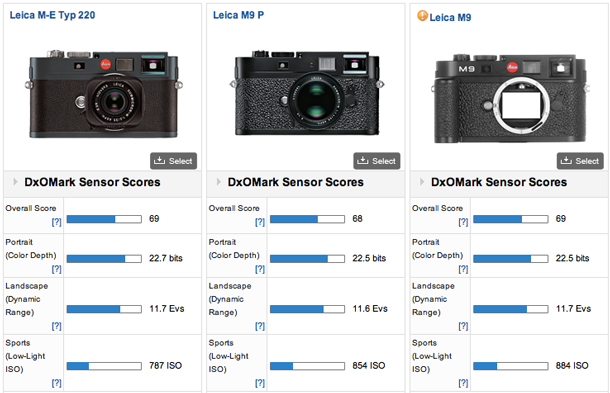These results have been around for a while, but maybe Leica photographers preferred to look the other way and DxOMark labs, commonly known for reliable sensor and lens tests, did not want to open a can of worms. In essence a repackaged DxOMark report on the Leica M9 sensor says Leica enthusiasts better be exited about the new Leica M Typ 240 because the old generation CCD offers — and please excuse my French — “the worst image quality DxOMark have tested on a full-frame sensor, with the exception of the 10-year-old Canon EOS 1Ds.”
The benchmark sensor indexing company DxOMark, calling itself the “trusted industry standard for camera and lens independent image quality measurements and ratings,” stirred up a hornets’ nest with its article Leica M9, M9-P and M-E Type 220 — Ahead of the New Leica M We Round Up the DxOMark Scores of its Predecessors.
Usually quoted as a reference site for quality for spot-on sensor evaluations, DxOMark has M9 aficionados scratching their heads. DxOMark found that the highly regarded cameras that break whole family budgets are inferior in image quality to even older CMOS-powered cameras… not to mention better scoring Micro Four Thirds cameras.
On popular Leica L·Camera Forum baffled users bewilderedly try to make sense of the findings. It has to be said that the M9 sensor is still the most advanced, commercially available CCD sensor. But whether DxOMark’s methodology of testing or the lack of the inclusion of all-important Leica lenses is to be blamed, the other side of the coin is that the anti-red-dot camp gleefully enjoys the findings. It’s what you could call the “social digital gap.”
For them, the low scores aren’t news, referring to luminance noise at high ISO and chroma noise at low ISO. But then again, the M sensor has the same dynamic range score as the Canon 5D Mark III. Simple fact is not all sensor renderings are equal. Leica users prefer the nature of the noise from the Leica CCD sensors, but that “look” or appeal is not reflected in the test scores, and how could it be reflected.

As we all know, there is much more to an image than just the plain stripped down sensor, but with a DxOMark overall score of 68, or 69 for the Leica M9, M9-P and ME Type 220, these cameras offer the worst image quality DxOMark have ever tested on a full-frame sensor, with the exception of the 10-year-old 1Ds.
Quoting from DxOMark:
The 24x36mm full-frame CCD sensor utilized in the Leica M Series rangefinder cameras produce significantly poorer RAW image quality, compared to results from DSLRs featuring a CMOS alternative.
No doubt Leica enthusiasts will assert we’re comparing apples and pears, and the advantages the Leica M system offers in terms of simple control, portability and discretion, as well as first class engineering, are more important.
It’s fair to say too these results purely examine the data from the sensor, excluding the impact top quality Leica M mount glass will have on the real world results. At base ISO sensitivities dynamic range and color depth scores aren’t quite as far away from competition.
Compared to the evolution of CMOS sensors used in the latest Nikon and Sony DSLRs however, the DxOMark Scores indicate a gulf in image quality, not only at base ISO but importantly at mid range sensitivities up to ISO 1600. While image quality drops off very quickly on digital Leica M cameras as you increase the ISO, the top end DSLR competition keep delivering the goods at staggeringly high sensitivities.
DxOMark is about to test the much anticipated M to see whether the new 24MP CMOS sensor addresses the issues and puts Leica back in the digital camera game. The M Typ 240 equipped with a custom-designed CMOSIS sensor is a notable break from the CCD sensors that Leica has stuck in its digital M cameras since the M8 was announced back in 2006.


